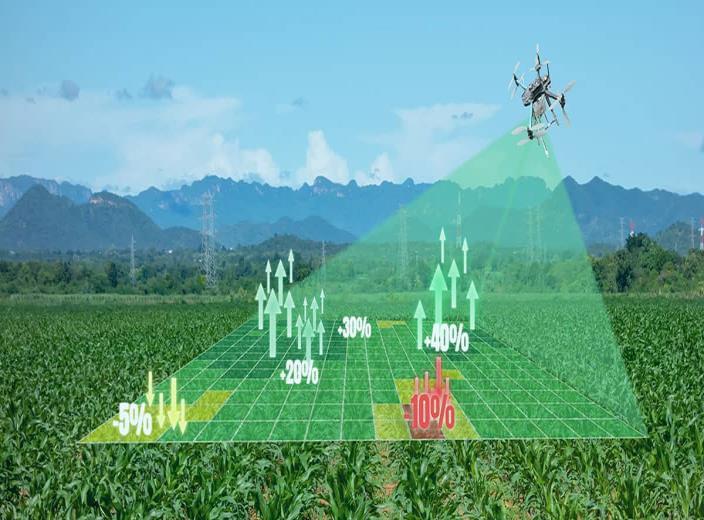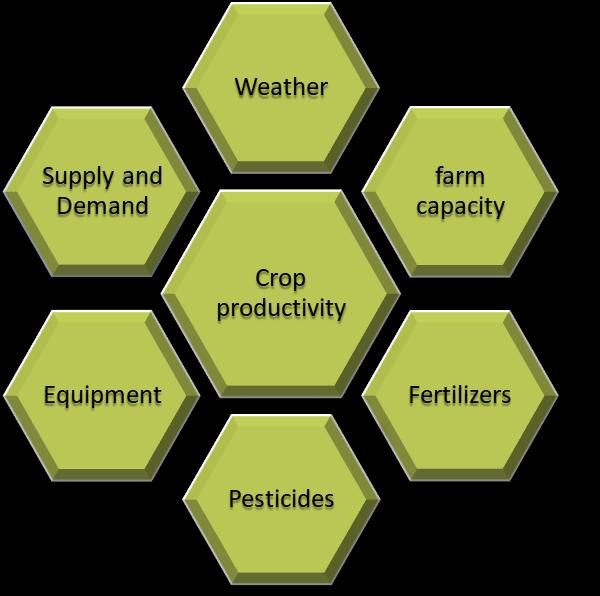
International Research Journal of Engineering and Technology (IRJET) e-ISSN: 2395-0056
Volume: 11 Issue: 07 | July 2024 www.irjet.net p-ISSN: 2395-0072


International Research Journal of Engineering and Technology (IRJET) e-ISSN: 2395-0056
Volume: 11 Issue: 07 | July 2024 www.irjet.net p-ISSN: 2395-0072
Surekha Bijapur1 , Sheela N S1 , Dr. Janapati Venkata Krishna2
1 Research Scholar 2 Associate Professor, 1 Department of Computer Science Engineering and Technology Srinivas University, Mangaluru , Karnataka.
Abstract - In the era of growing population there is a high need to increase the agricultural potential. Sustainable development is also of at most concern. Growing demand for the food burdens the nature with excessive chemicals. Agriculture and agro-industries are considered to be highly important for the country’s economic development as they contribute significantly in Gross Domestic Product (GDP). Although the service and industrial sectors showed higher rates of growth and have been contributing higher percentages to Gross National Product (GNP), Worldwide, expansioninagriculturalcommoditiesandfoodproductshas been accompanied by significant increase in usage of agricultural inputs such as fertilizers, pesticides, farm machinery and improved seed material. The use of such intensive inputs in agriculture and access to plentiful energy, where they were previously limited or unavailable, has enabled an increase in food production and thus provides betterfoodandlivelihoodsecurity. Thepaperdiscussesabout the different patents given in the area of sustainable agriculture. In the course of action, we discuss about some of the modern technologies which have helped the framers not only in increasing crop productivity but also in sustainable development.
Key Words: agricutlture, sustainability, machine learning, precision agriculture
Populationoftheworldisgrowinginanexponentialway. Buttheagriculturallandisnotgrowingatthesamerate.In fact,itisactuallyshrinkingduetoconstructionalactivities. The large population has to be fed in the available land, hence there is a need to increase the crop productivity. Agriculturehasshifteditsscopeandfocusesmoretowards commercialization and export-orientation. Farmers have startedusingchemicalfertilizersasasolutiontoincreasethe productivity but it is actually harming the nature and depleting the soil nutrients which again lead to the under performanceinthefuturedays.Thoughthesechemicalsare temporarily increasing the productivity, they are harming the human health as well as the nature's health so it is crucialtoincreasefarmperformancewithoutdepletingthe nature.
Farmerswhicharegrowingthesamecropwillbeusingthe same fertilizers and also using the same quantity of fertilizers many are times the crop might already be containingthesenutrientssincetheirfarmsaresituatedin differentareasobviouslythenutrientsavailableintheland willalsobedifferent.
The reason why farmers do not take interest on the soil testingisthateithertheyneedtotraveltotheplacewhere thetestingtakesplaceorthetesterhimselfhastovisitthe land. Hence, they choose their own decisions. Since the testingisdoneonlyonaparticularsamplethedecisionswill betakenbasedontheresultofthisparticularsampleonly. Butthenutrientsandmoisturecontentdiffersfromonepart toanotherpartofthelandthesedecisionsoftenleadtothe economiclossesalongwithspoilingthenature.

Thoughweusethesameinputsinsamequantity,theyieldat differentpartsofthesamelandisdifferent.Sincethesame quantityofinputs(fertilizers,water,pesticides)areused,the result expected is also the same. But this thing doesn’t happeninmanyofthecasesasillustratedinthefollowing picture.
This leaves us to think on different internal and external factorsthataffectthehealthoftheplant.Followingarethe major factors which contribute to the plant health and productivity.

International Research Journal of Engineering and Technology (IRJET) e-ISSN: 2395-0056
Volume: 11 Issue: 07 | July 2024 www.irjet.net p-ISSN: 2395-0072
Worldwide,expansioninagriculturalcommoditiesandfood products has been accompanied by significant increase in usage of agricultural inputs such as fertilizers, pesticides, farmmachineryandimprovedseedmaterial.Theuseofsuch intensiveinputsinagricultureandaccesstoplentifulenergy, where they were previously limited or unavailable, has enabledan increase in food productionandthus provides betterfoodandlivelihoodsecurity.Indevelopingcountries increased growth in agricultural production depends on continuous improvement through technological changes. This requires a sustained and rapid growth in the use of agriculturalinputssuchasseeds,fertilizers,pesticide,farm implements,farmmachinery,etc.,
A number of different factors can cause agricultural productivitytoincreaseordecrease.Itisimportanttonote that productivity is not an absolute measure, but rather a reflection of the ratio between inputs and outputs. A field that produces twice as much of some crop as it did in a previousyearisnotnecessarilytwiceasproductive;ifthe farmerspenttwiceasmuchonthatfield,thenetchangein productivitywouldbezero.
Factorsthataffectfarmproductivityandoftencan'tbeinthe controlofthefarmerare:

Weather - unusual weather patterns, such as drought, a prolonged rainy season, early or late frosts and other factors can ruin crops and bring productivity down. Ray and Gerber have used detailed crop statistics time series for ~13,500 political units to examine how recent climate variabilityledtovariationsinmaize,rice,wheatand soybeancropyieldsworldwide.Whilesomeareas shownosignificantinfluenceofclimatevariability, in substantial areas of the global breadbaskets, >60% of the yield variability can be explained by climate variability. Globally, climate variability accounts for roughly a third (~32–39%) of the observedyieldvariability[16]
The Capacity of a Given Farm -soilcan'tbeforced toproducebeyonditscapacity,althoughthereare methods that can be used to improve production capacity,suchasproperfertilizingtoaddnutrients tothesoilsothatitcansupportmorecrops.Mixed farmingisonesuchtechniquewhichcanbeusedto improve the soil nutrients. Here the nutritious outputofonecropwillbeabsorbedbyanothercrop tosupportitsowngrowth.
Fertilizers -Fertilizerisgenerallydefinedas"any material,organicorinorganic,naturalorsynthetic, which supplies one or more of the chemical elementsrequiredfortheplantgrowth"..Justlike humansandanimals,plantsneedadequatewater, sufficient food, and protection from diseases and pests to be healthy. Commercially produced fertilizers give growing plants the nutrients they craveintheformtheycanmostreadilyabsorband use: nitrogen (N), available phosphate (P) and soluble potash (K). Elements needed in smaller amounts,ormicronutrients,includeiron(Fe),zinc (Zn),copper(Cu)andboron(B).Themainaimofthe industry is to provide the primary and secondary nutrients which are required in macro quantities[15].AspertheFertilizerControlOrder (FCO) 'fertilizer' means any substance used or intendedtobeusedasfertilizersofthesoilandor crop and specified in part A of Schedule I and includesamixtureoffertilizersandspecialmixture of fertilizers. Primary nutrients are normally suppliedthroughchemicalfertilizers.
Pests occurred or not by certain weather conditions -inadditiontospoilingcrops,pestscan add significantly to the costs of producing a crop. Controlling them may require measures such as fencing, chemical or biological treatments, companion planting or crop rotation, all of which changetheratioofinputstooutputs
Available Equipment -inregionswhereaccessto mechanized farm equipment is low, agricultural productivitycanalsobelowaspeoplehandletheir crops primarily by hand. This involves a big investment of time, energy and money and also limitsthetotalcapacityoftheland
The Supply and Demand in the Market -farmers will adjust their activities to meet the needs of consumers and this can have an impact on agricultural productivity. In some cases, governments even pay subsidies to farmers to compensatethemfornotgrowingcrops,whichcan skewproductivitymeasures.

International Research Journal of Engineering and Technology (IRJET) e-ISSN: 2395-0056
Volume: 11 Issue: 07 | July 2024 www.irjet.net p-ISSN: 2395-0072
For agricultural productivity innovation is a key factor. If farmers want to increase their productivity, they need to farmsmarter,byusingfarmmanagementsystemAgrivi.It helpsthemmanagewholefarmproduction,fromtrackingof activitiesonallfields,consumptionoffertilizers,pesticides, work hours of workers and mechanization, to tracking of financesandcompletefarmanalysisandreports.Investment in developing new farming techniques and in researching newapproachestofarmingneedtobeonadailybasis.
Precisionagriculture(PA)isacuttingedgetechnologywhich makesuseofmachinelearningconcept.Itisusedtohelpin making decisions such as crop type, adequate quantity of fertilizers, pesticides and water. PA leads to effective utilizationoftheresourceswhicharenotsoabundantinthe nature.Since,itadvisestousetheorganicmanureinplaceof thechemical-basedfertilizers.Inthecaseswheretheorganic fertilizers are not adequate enough the chemical-based fertilizerswillbeused,whichhavetobeofminimalquantity.
It uses various tools to achieve the task. agricultural crop type prediction is done using special interpolation and machinelearningforwardandagriculturalspecialistmake informed crop decisions plant efficiently and all of it resources with this technique it's since it can accurately evaluate the soil nutrient levels and weather patterns it presents itself as a boon in the modern agriculture geostatisticalmethodssuchaskriginginterpolation[1]areused to access soil nutrient levels specially across the field this paper analyses the patents given in the agricultural field which prove themselves as beneficiary in the sustainable farming.
Followingaresomeofthepatentsreceivedinthisfield:
1) Barsamian and Garrison(2018) state that the farmingdevicewillbefedwithasetofinstructions andtheinputinformation. Thedevicewillbeusing thisinformationand makedecisions basedon the instructions given to it.The farming device acts accordingtothedecisionsmade,whichcausesthat devicetoperformanaction.Theactionincludesat leastoneofreplantingofaparticulararea,spraying ofachemicalintheparticularareaoractivatingan irrigationsystem.
2) Cohen(2018)workedonthecomputer-implemented methodstoexercisePA.Thedataisfedtoaparticular device.Thedevicepredictsoutputconditions,suchas diseases,saltdamage,soilproblems,waterleaksand generic anomalies. The computer platform stores siteandcropdatasetsandprocessedsatelliteimages for the orchards. An orchard data learned model predicts a propensity for existence of output conditionsassociatedwiththecropsbasedonthe data values for the variables of the site and crop datasets.Aprecisionagriculturemanagementmodel
integratestheorcharddatalearnedmodelwiththe satellite model to accurately predict the output conditions.
3) Mewes and Salentiny (2015) have proposed a modeling framework for evaluating the impact of weather conditions on farming and harvest operations which applies real-time, field-level weather data and forecasts of meteorological and climatological conditions together with userprovided and/or observed feedback of a present state of a harvest-related condition to agronomic models and to generate a plurality of harvest advisoryoutputsforprecisionagriculture.Aharvest advisory model is simulated that predicts the impacts of this weather information and userprovided or observed feedback in one or more physical,empirical,orartificialintelligencemodels ofprecisionagriculturetoanalyzesoil,crops,plants and resulting agricultural commodities, and provides harvest advisory outputs to a diagnostic support tool for users to enhance farming and harvestdecision-making,whetherbyprovidingpre, post-, or in situ-harvest operations and crop analyzes.
4) Reimannproposeda system forpredictingsoilor plant conditions in precision agriculture with a classificationofmeasurementdataforprovidingan assignmentof a measurementparcel toclassesof interest. The assignment is used for providing actionrecommendations,toafarmerand/ortoan agriculturaldevicebasedonacquiredmeasurement data,particularlyremotesensingdata,andwherein a classification model is trained by a machine learningalgorithm,e.g.relyingondeeplearningfor supervised and/or unsupervised learning, and is potentially continuously refined and adapted to a feedback procedure, through better and accurate decisionsaremade.
5) Guan and Peng(2021) have developed an integrated multi-scale modeling platform. It is utilized to assess agricultural productivity and sustainability. The model is used to assess the environmentalimpactsofagriculturalmanagement from individual fields to watershed basin to continental scales. In addition, an integrated irrigation system is developed using data and a machine-learning model that includes weather forecastandsoilmoisturesimulationtodetermine adequate requirement of water for farmers. Crop coverclassificationpredictioncanbeestablishedfor an ongoing growing system using a machine learningorstatisticalmodeltopredicttheplanted croptypeinanarea.

International Research Journal of Engineering and Technology (IRJET) e-ISSN: 2395-0056
Volume: 11 Issue: 07 | July 2024 www.irjet.net p-ISSN: 2395-0072
6) SibleyandIbarria(2023)haveproposedamethod to implementmachinelearning(ML) algorithm to determinethequalityofcrops.Oneormoreimages ofaregionofanagriculturalenvironmentnearthe treatmentsystemarecaptured,andfedtotheML algorithm.Byanalyzingmultiplesuchimages,the ML algorithm gives recommends different suggestions. Multiple processing systems will determine the parameters which are underperforming.Bettercropdecisionsandinput requirements are determined based on these results.
7) Bao Tran(2023) has adapted an agricultural method which focused on the contaminants that affectedthegrowthofplants.Theyusedapositive air pressure chamber to prevent outside contaminantsfromenteringthechamber;growing cropsinapluralityofcellsinthechamber,eachcell having multi-grow benches or levels, each cell further having connectors to vertical hoists for vertical movements in the chamber; maintaining pre-set temperature, humidity, carbon dioxide, watering and lighting levels to achieve predetermined plant growth; using motorized transport rails to deliver benches for operations includingseeding,harvesting,growmediarecovery, andbenchwash;dispensingseedsinthecellwitha mechanical seeder coupled to the transport rails; growing the crops with computer controlled nutrients, light and air level; and harvesting the crops and delivering the harvested crop at a selectedoutletofthechamber.
Conclusion
Usingmachinesandequipmenthasbecomeanintegralpart oftheagriculture.Theroutineworksareusuallyhandledby themachinesinanhasslefreeway. Croptypedecisionsand assessing the plant health require huge data; so machines are used in this process too. Different machine learning algorithmshavebeenemployedinthisway.Thestudyhas extensively analyzed the different patents in the area of precisionagriculture.Thesearetheapplicationsofmachine learningtechnologies.Thesetechniquesaretheneedofthe dayasthegrowthisimportantbutat thecostofspoilingour ownenvironment.Researchanddevelopmentaregoingon toreducetheoverallcostofimplementationsothateventhe smallfarmerscanalsoafford.
References
[1]Burrough,P.,McDonnell,R.,1998.Optimalinterpolation using geostatistics. In: Principles of Geographical InformationSystems.OxfordUniversityPress,pp.132–162.
[2]Schimel,D.,Schneider,F.D.,2019.Fluxtowersinthesky: global ecology from space. New Phytol. 224 (2), 570–584. https://doi.org/10.1111/nph.15934.
[3]Koenig,W.D.,1999.Spatialautocorrelationofecological phenomena. Trends Ecol. Evol. 14 (1), 22–26. https://doi.org/10.1016/S0169-5347(98)01533-X
[4]Legendre, P., 1993. Spatial autocorrelation: trouble or new paradigm? Ecology 74 (6), 1659–1673. https://doi.org/10.2307/1939924
[5]Burrough,P.,McDonnell,R.,1998.Optimalinterpolation using geostatistics. In: Principles of Geographical InformationSystems.OxfordUniversityPress,pp.132–162.
[6]MartaJemeljanova,EvelynUuemaa,“Adaptingmachine learningforenvironmentalspatialdata-Areview”Ecological Informatics·May2024.DOI:10.1016/j.ecoinf.2024.102634
[7] Holger Hoffmann,Christian Bitter,Ole Peters,Bjoern Kiepe;BASFAgroTrademarksGmbH,assignee.Creationof digitalcropmaps.SpainpatentES2947014T32018
[8]PaulM.Barsamian,DanielP.Garrison,AdalbertoGonzalez Ayala,ArtemisKoutsorodi,BadriLokanathan,AnkurMathur, Juan Carlos Mendez, Pramila Mullan, Gregory P. Spata, BrandonWebber;AccentureGlobalSolutionsLtd,assignee. AustraliapatentAU2018267537B2,2018
[9] Harris Lee Cohen; Computer implemented methods, computer-readable medium and systems for a precision agriculture platform that detects healthy conditions. US patentUS11812684B22018
[10]JohnJ.MewesDustinM.Salentiny; DTNLLC.,assignee. Harvest advisory modeling using field-level analysis of weather conditions and observations and user input of harvest condition states and tool for supporting managementoffarmoperationsinprecisionagriculture.US patentUS9292796B12015
[11]Bernd Reimann,Alexandre HEILI,Dhiraj MOHAN,José DEBONI; Hexagon Technology Center GmbH., assignee. Method for prediction of soil and/or plant condition. US patentUS11432469B22017
[12]KaiyuGuan,BinPengChongyaJiangWangZhouJingwen ZhangYizhiHuangJianPengSiboWANG;UniversityofIllinois, assignee. Accessing agriculture productivity and sustainability.USpatentUS20220061236A12021
[13] Gabriel Thurston Sibley, Lorenzo Ibarria, Curtis Dale Garner, Patrick Christopher Leger, Dustin James Webb; Verdant Robotics Inc., assignee. Applying multiple processing schemes to target objects. US patent US11937524B22023

International Research Journal of Engineering and Technology (IRJET) e-ISSN: 2395-0056
Volume: 11 Issue: 07 | July 2024 www.irjet.net p-ISSN: 2395-0072
[14]BaoTran;Farmecosystem.USpatentUS11854033B2 2023.
[15]Dr.VijayShivajiMistary,“AGRICULTUREINPUTSAND THEIRIMPORTANCEFORPRODUCTIVITY-ANOVERVIEW”. EPRA International Journal of Agriculture and Rural EconomicResearch(ARER)-Peer-ReviewedJournalVolume: 10|Issue:3|March2022|JournalDOI:10.36713/epra0813| ISSN:2321–7847
[16]DeepakK.Ray,JamesS.Gerber,GrahamK.MacDonald &PaulC.West,“Climatevariationexplainsathirdofglobal cropyieldvariability”.NATURECOMMUNICATIONS|6:5989 | DOI: 10.1038/ncomms6989 | www.nature.com/naturecommunications
© 2024, IRJET | Impact Factor value: 8.226 | ISO 9001:2008 Certified
|